When it comes to the showdown between the Roomba i4 vs i7, my vote goes firmly to the Roomba i7. The reasons are quite straightforward.
Firstly, the Roomba i7 delivers slightly better cleaning performance, which is always a plus. Additionally, its advanced navigation technology, including the use of cameras, opens up a range of valuable mapping functions like “keep out zones” and “clean zones.” These features are not only interesting but also highly practical. While the Roomba i7 comes at a higher price point, I believe it’s a worthy investment.
However, if you’re working with a budget and don’t need advanced features like “keep out zones” and “clean zones,” the Roomba i4 is still a solid choice. It offers almost the same level of cleaning performance while allowing you to save a significant amount of money. In summary, it’s a smart and budget-friendly alternative.
Roomba i4 vs i7: Comparison Chart




Roomba i4 vs i7: Differences
The Roomba i7 emerges as the victor in the face-off against the Roomba i4, securing a decisive victory with a final score of 3 wins and 1 tie. Stick around to delve into the specifics and discover what sets these two robot vacuums apart.
Cleaning Performance
The Winner: Roomba i7
Hard Floor
| Roomba i4 | Roomba i7 |
|---|---|
| ≈ 96% | ≈ 98% |
Both the Roomba i4 vs i7 are pretty impressive when it comes to hardwood floors. They effortlessly picked up almost all the debris from small to large debris on my hardwood floor.
Both of them come equipped with a side brush that gets into the tricky corners and along the walls. But while these side brushes do a decent job, they sometimes tend to scatter debris around. This little quirk means that neither of them can claim a perfect 100% score for hard floor cleaning.
Interestingly, I found the side brush on the Roomba i4 tended to scatter debris around more than the i7’s. It’s a bit puzzling, and I can’t say why this happens. But just based on what I observed, I’d say the Roomba i7 definitely takes the edge when it comes to cleaning the edges and hard floor.
Don’t set your expectations for perfection, but anyway, they do a pretty darn good job on this surface.
Carpet
| Roomba i4 | Roomba i7 | |
|---|---|---|
| Low-pile carpet | ≈ 96% | ≈ 96% |
| High-pile carpet | ≈ 85% | ≈ 86% |
When it comes to carpets, both the Roomba i4 and Roomba i7 deliver fairly similar performances. On this surface, they do not perform as well as on the hard floor.
On both low-pile and high-pile carpets, they can pick up larger debris decently, but things get a bit tricky when it comes to finer debris like baking soda or sand.
If your home is all about plush, high-pile carpets and there’s a significant amount of fine debris, don’t expect these robots to be able to suck up all that dust in a single pass as effectively as a big upright vacuum cleaner would. I mean, they still can do that but require multiple passes to vacuum entirely.
Hair Pick-up
| Roomba i4 | Roomba i7 | |
|---|---|---|
| 5-inch Strands | ≈ 59% | ≈ 59% |
| 7-inch Strands | ≈ 73% | ≈ 70% |
The Roomba i4 and i7 are equipped with the Dual-Multi Surface Rubber Brushes, which are marketed as being tangle-resistant. Now, let’s find out if they truly live up to the tangle-free promise during my hands-on testing!
When it comes to human hair pickup, both of these vacuums managed to collect all the hair, but a significant portion of it didn’t make its way into the dustbin. Instead, around 50 to 70% of the hair ended up entangled around their side brushes, brush rolls, and axles, requiring manual cleaning. Thankfully, removing the hair from the brush roll was a breeze due to its rubber design, which is far less prone to tangling compared to traditional bristle brushes.
When dealing with pet hair, both the Roomba i4 and i7 faced some challenges when it came to picking up shorter strands on hard surfaces. There were a few stubborn tufts of hair that simply eluded their grasp. However, this proved to be a common challenge among many Roombas I’ve had experience with. It remains uncertain whether this issue stems from limited airflow and suction, their dual brush roll design, or possibly a clearance problem, all of which could contribute to their subpar performance in this particular task.
On the bright side, when it comes to pet hair tangling, the outcome can be a perfect 0%. Every bit of pet hair they manage to collect gets neatly deposited into the dustbin, with no pesky fur entangling around the brush roll whatsoever.
Design & Usability
The Winner: Roomba i7
Dimensions, Weight & Aesthetics
| Roomba i4 | Roomba i7 | |
|---|---|---|
| Dimensions (WxH) | 13.26 x 3.6 inches | 13.26 x 3.6 inches |
| Weight | 7.44 lbs. | 7.44 lbs. |
Roomba i4 and i7’s dimensions and weight are almost identical. Both of these Roombas, like many others in the i line, features a circular design with a relatively low profile. At 3.6 inches in height, this low profile allows them to easily slide under most furniture, which is a definite advantage.
However, it’s worth noting that this profile can be a limitation when it comes to surmounting steep 90-degree obstacles. In such cases, a simple ramp solution might be necessary, especially for homes with elevated door thresholds.
Regardless of whether you opt for the Roomba i7 or the i4, one thing remains undeniable: you can place your trust in the exceptional craftsmanship of this premium American manufacturer! Both models exhibit impeccable build quality.
It’s worth noting a minor distinction: the i7 boasts a glossy. It’s shiny but this surface can be prone to fingerprints. Meanwhile, the i4’s surface is crafted from a “cloth-like” material, expertly avoiding any issues with fingerprints.
Battery Life
| Roomba i4 | Roomba i7 | |
|---|---|---|
| Run Time | 80-100 Minutes | 70-75 minutes |
| Charging Time | 3 hours | 2 hours |
The Roomba i7 is equipped with a 1,800mAh lithium-ion battery and it can run 75 minutes of continuous cleaning. On the other hand, the Roomba i4 takes it up a notch with a 20% larger battery, delivering a generous 100 minutes of cleaning.
However, these numbers are only achieved under ideal conditions when they are based on brand-new batteries. In practice, I’ve observed both devices experiencing a noticeable drop in battery life over time. I’ve never been overly impressed with their battery life.
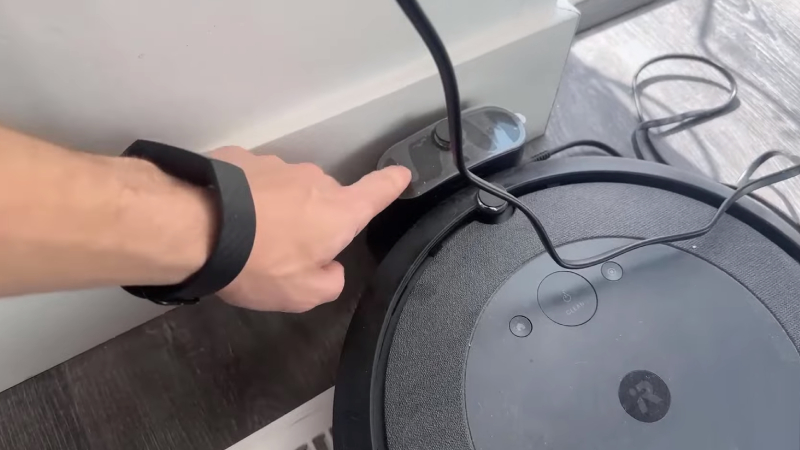
While it’s true that both these robots have relatively short battery lives, they do come with a handy feature – the ability to recharge and resume. Thanks to this feature, we won’t have to constantly monitor them and manually return them to the charging dock to complete their cleaning job throughout your entire house or apartment.
There’s a noteworthy distinction in the recharge and resume features between these two products. In particular, the Roomba i7 boasts Smart Recharge and Resume. The “Smart” aspect means that the Roomba i7 takes a more intelligent approach compared to the i4.
Thanks to its Smart Map, the i7 can discern what areas have already been cleaned and what is left. Consequently, it will only recharge its battery enough to finish the remaining task, rather than fully recharging. This clever strategy saves a significant amount of time when compared to the Roomba i4, which fully recharges before resuming cleaning.
However, for larger homes, a full cleaning cycle that includes multiple recharges can take a considerable amount of time. So, despite this useful feature, I still find myself wishing for longer battery life on these two robots.
Navigation
Navigation technology is another crucial factor that, in my opinion, impacts overall cleaning performance. In this regard, the Roomba i7 once again takes the lead.
The Roomba i4 relies on relatively basic navigation technology. Unlike the Roomba i7, it lacks a camera, so instead of visual navigation, it utilizes floor sensors on its underside to navigate. It moves in an organized and systematic manner, cleaning an entire level of your home in orderly rows. The absence of a camera means you can deploy the Roomba i4 for cleaning tasks even in total darkness.
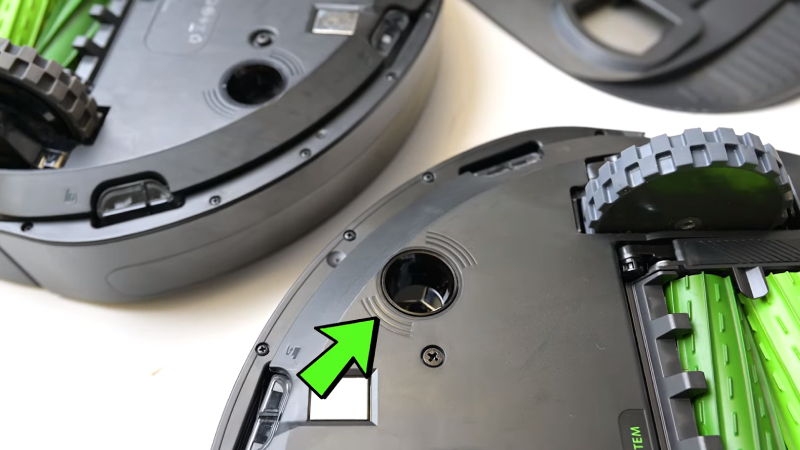
Roomba i7 follows a slightly different path. It’s equipped with a camera positioned atop, which grants it a touch more efficiency in navigation. However, there’s a minor drawback to the camera-based navigation: the Roomba i7 takes a bit more time to complete the task in lower lighting conditions. In complete darkness, it can’t carry out its tasks. But for me, this is not a significant issue since I probably won’t use the robot vacuum during nighttime. Who wants to disrupt their sleep, right?
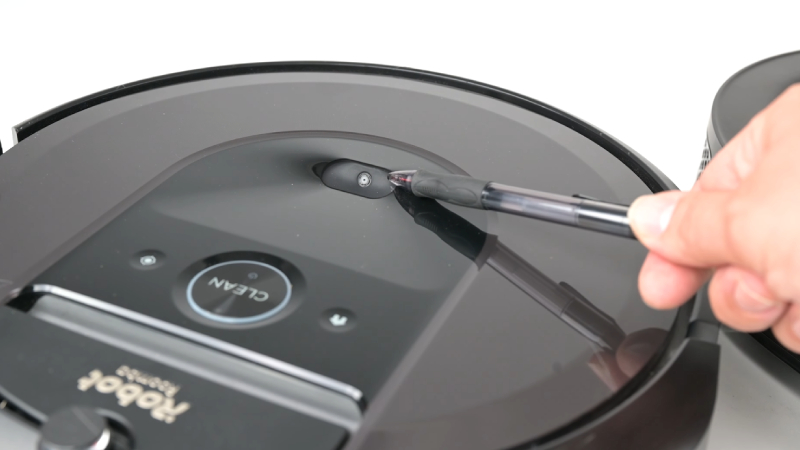
Moreover, its camera enhances its obstacle-detection capabilities. Thanks to this, the i7 adeptly avoids most obstacles in its path. In those rare instances when the iRobot robot vacuum fails to recognize an obstacle, its bumper comes into play. However, such occurrences are few and far between. It bumps gently and won’t cause any damage to your furniture.
Control
The Winner: Roomba i7
Manual Control
Both models come equipped with physical buttons located on the robot vacuum cleaner itself. These buttons come in handy when your phone isn’t within reach or when you don’t have access to a Wi-Fi network for the app or voice control.
There are times when I just want my vacuum to do its job without any specific cleaning required, and these physical buttons provide a straightforward and efficient way to get the process started.
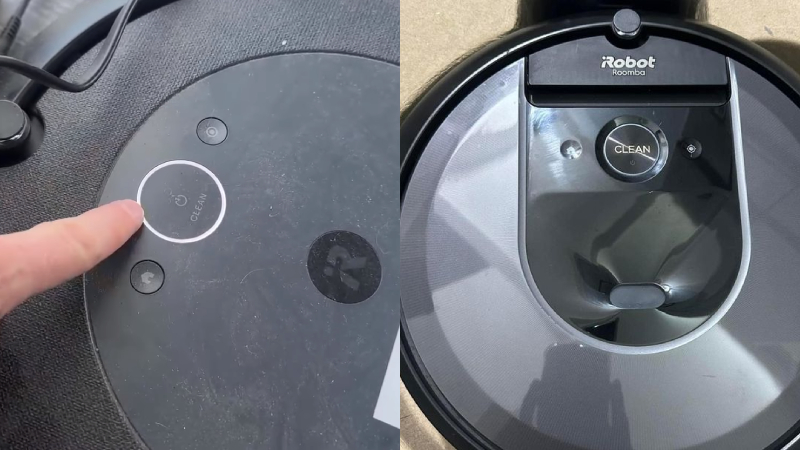
Their user interface included three buttons, including:
- “Spot Cleaning” for targeting a specific area.
- “Home” to initiate the return to the home base.
- “Clean” to start or stop the vacuuming cycle.
Voice Control
If you’re a fan of voice commands, these robots are a perfect match. They integrate with popular voice assistants like Alexa, Google Assistant, and even Siri, offering more than just basic commands like “start,” “stop,” or “return to the charging station.”
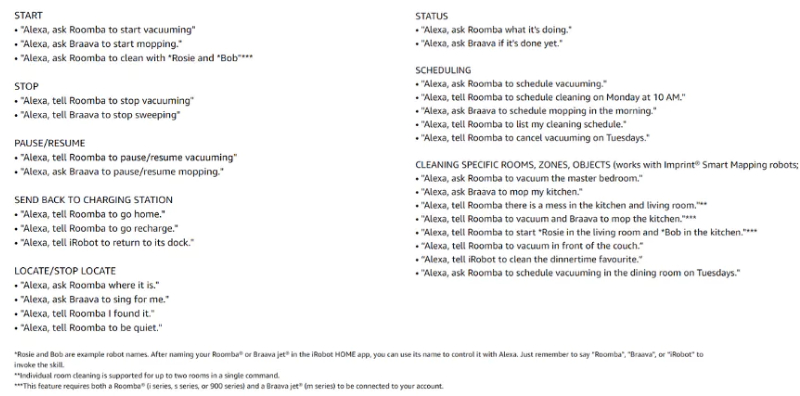
Don’t worry, you don’t need to learn and say every word of the above commands exactly. The voice control is quite advanced, and they can understand various voice command variations. The voice assistant also asks smart and relevant questions, such as, “Which room would you like me to clean?” “Which date do you want to schedule to clean”. It’s a fun and interactive way to communicate with your robot vacuum.
App Compatible & Mapping
When you take control of these Roombas remotely through the iRobot Home App, you unlock access to all their advanced features.
After creating the map of the cleaned area, you can label rooms, set cleaning schedules, request the robot to clean specific rooms and devise or merge rooms using the iRobot app. These are the fundamental features that both the Roomba i4 and i7 offer.
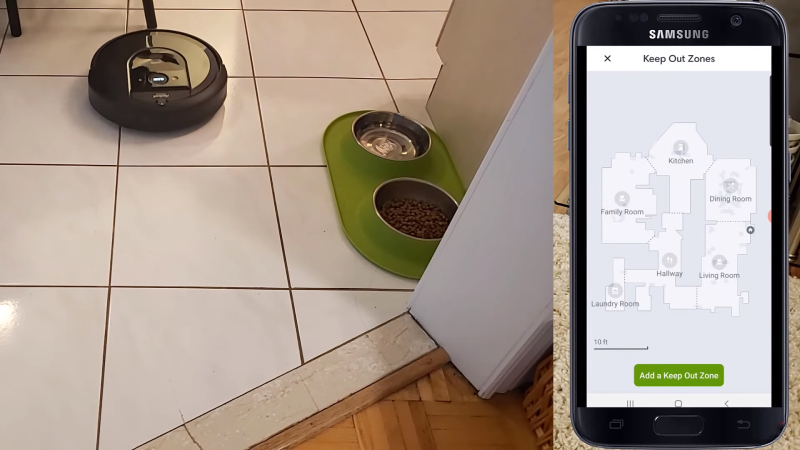
The Roomba i7 goes a step further by offering features like “Keep out zones” and “Clean zones,” which the Roomba i4 lacks. This sets it apart as a more advanced option.
The Keep-out zones feature is an absolute lifesaver. Imagine you have a dedicated kid’s play area at home, and you don’t want the vacuum cleaner to go near it because it could be unsafe for your kid. Well, it provides the solution: simply draw boxes on the app to mark those off-limit areas. The best part? The app allows you to create as many zones as you need, giving you unparalleled control and peace of mind.
The Roomba i4 doesn’t have this app feature, but the brand throws in a cool compensation: they give you a Virtual Wall in the package. Just place that Virtual Wall where you want the Roomba i4 to stay away from, and boom, you’ve created a real-life “keep out zone.” It’s like having the physical version of that fancy digital feature! However, it cannot be as convenient as the real digital keep-out zone because you cannot create multiple zones at the same time.
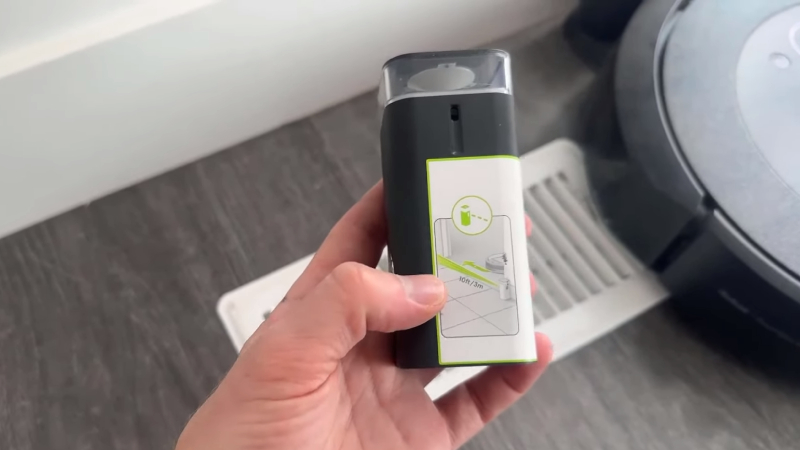
To top it off, the Roomba i7 has the capability to scan and store 10 maps for multi-floor homes, whereas the Roomba i4 is limited to saving just 1 map.
Cleaning & Maintenance
The Winner: Tie
Both the Roomba i4 and i7 share the same 400 ml capacity for their dustbins, which, to be honest, is on the smaller side. If you have pets or kids, be prepared to pause and empty the bin several times during each cleaning cycle. Neglecting this task could lead to the suction tube becoming clogged.
Honestly, I feel that constantly keeping an eye on the vacuum’s dustbin status can feel like babysitting! That’s why I lean towards the Roomba i4+ and Roomba i7+ versions. They come with the Clean Base, which offers auto dust disposal. Alternatively, you can purchase the Clean Base separately for the Roomba i4 and i7, giving you the same convenience.
Price
The Winner: Roomba i4
The iRobot Roomba i7 comes loaded with advanced features, setting it apart from the Roomba i4. It boasts superior navigation, a broader range of app functions, and the convenience of multi-floor storage. This is also reflected in the price. This robot vacuum falls into the luxury tier of iRobot’s lineup, offering top-notch performance and cutting-edge technology.
On the other hand, the Roomba i4 opts for a more budget-friendly approach by forgoing some of the high-end features found in its pricier counterpart. This decision translates to a noticeably lower price point, making the Roomba i4 an attractive choice for those seeking a mid-range robot vacuum. Despite its affordability, the Roomba i4 doesn’t compromise on cleaning performance.
Quick Rundown Of Roomba i7
- POWERFUL PERFORMANCE AND POWERFUL PICK-UP - Pulls in stubborn dirt and messes with a Premium 3-Stage Cleaning System and 10X the Power-Lifting Suction. (Compared to the Roomba 600 series cleaning system)
- GUIDED BY SERIOUS SMARTS - With vSLAM navigation, the i7 learns the layout of your home and builds personal Smart Maps, enabling it to expertly clean and navigate in neat, efficient rows.
- VACUUMS MESSES IN THE MOMENT - Cleaning crumbs is now as easy as “Roomba, clean under the kitchen table.” A simple request to your voice assistant or via the iRobot Home app enables the i7 to clean messes for you, right when they happen.
- COMPLETE CONTROL OF YOUR CLEAN - With Smart Mapping, your robot knows your kitchen from your living room, so you can decide where it cleans and when. With Keep Out Zones, your robot knows to avoid sensitive areas like pet bowls or play areas.
- A CLEAN UNIQUE TO YOU - The Roomba i7 robot vacuum is smarter than ever, learning where and when you normally clean and suggesting personalized schedules so you can focus on everything else.
Quick Rundown Of Roomba i4
- 20% LARGER BATTERY – Larger battery for extended runtime. Compared to other Roomba i series Robot Vacuums
- CLEANS THE ROOMS YOU WANT WHEN YOU WANT - iRobot OS learns and personalizes your cleaning with Imprint Smart Mapping technology so you can direct it to clean any room you want, any time you want—either on a set schedule or in the moment.
- SWEEPS UP DUST, DIRT AND DEBRIS WITH EASE - Experience a comprehensive clean with the powerful 3-Stage Cleaning System that pulls in dirt, debris, and pet hair from wherever it hides.
- PRECISION CLEANING IN TIDY ROWS - Cleans intelligently in straight lines back and forth, to thoroughly clean your floors while navigating around furniture. When it needs to recharge, it will resume right where it left off ensuring a complete clean.
- FOCUSES ON DIRT - iRobot's Patented Dirt Detect Technology allows the Roomba i4 EVO robot to detect dirtier areas of your home and clean them more thoroughly.
Product Videos
Related Articles to Roomba I7
- Roomba i3 vs i7: Which Robot Vacuum Is Right For You?
- Roborock S7 Vs Roomba I7: Which Will Win The Battle Of Performance?
- iRobot I7 Vs S9: Which High-End iRobot Roomba is Better?
Related Articles to Roomba I4
- Roomba i4 vs j7: Compare An Entry-Level vs. A Premium Vacuum
- Roomba i4 vs i8: Which Robot Vacuum Is Better?
- Irobot I1 Vs I4: Is There A Better Value Option Out Of The Two?
- Roomba I4 Vs I6: Budget-Friendly Robot Vacuums – Which is Better?
- Roomba i3 vs i4: Which Affordable Entry-Level Roomba Is the Better Choice?
- Roomba I4 Vs I5: Which Is Really For You?
- Roomba 960 Vs I4: Which Robot Vacuum Is Better?
- Roomba i4 vs 675: A Head-To-Head Comparison
References:

Richard B. Schmidt is a prominent figure in the vacuum cleaner industry, boasting over 15 years of expertise. Armed with a Robotics Engineering degree from Northeastern University and a Master’s in Consumer Science from Harvard, his unique blend of technical knowledge and consumer insights positions him as a sought-after authority in vacuum cleaner evaluation. Richard’s career began at Dyson, where he contributed to the development of innovative vacuum models. Transitioning to advocacy and reviews, he co-founded the first Vacuum-focused blog in 2008, offering comprehensive analysis and user guides for various vacuum cleaners. In 2020, he founded RoboMop.net, providing ongoing insights through columns and buyer’s guides.
